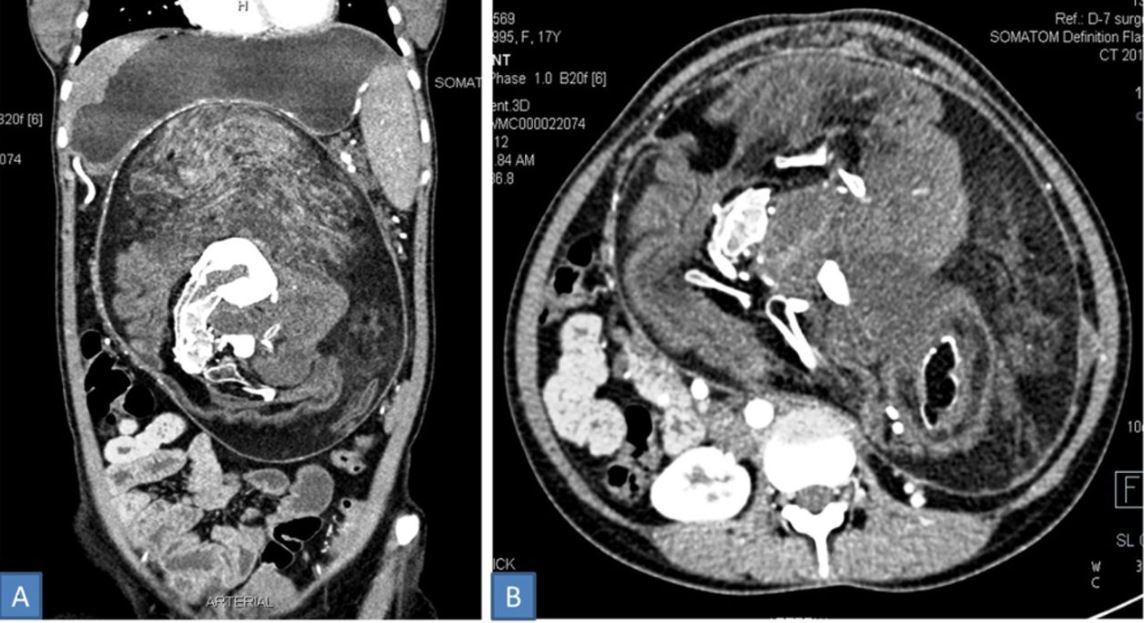Doctors Find Bizarre Mass of Bone, Teeth & Hair in Teen's Stomach. It Was Her Own Twin.
The teen had an extremely rare condition called "fetus in fetu."

A teenager in India was discovered to have a bizarre mass of bone, teeth and "hairy cheesy material" in her abdomen, according to a new report of the case. It was her own "twin" growing inside her, the result of an extremely rare condition called "fetus in fetu."
The 17-year-old went to the doctor after developing a lump in her abdomen that had been gradually increasing in size over the last five years, according to the report, published Aug. 12 in the journal BMJ Case Reports. The teen told doctors that she sometimes experienced abdominal pain and a feeling of fullness, even when she had not eaten much food.
A CT scan revealed that the teen had a large mass in her abdomen that appeared to contain multiple bones "resembling the shape of vertebrae, ribs and long bones," the authors wrote.
Doctors diagnosed the teen with fetus in fetu, a condition that is estimated to occur in only about 1 in 500,000 people worldwide.
Related: 27 Oddest Medical Case Reports
The new case is even more unusual because it was diagnosed in a teenager, whereas most previous cases have been found in infancy or early childhood, the authors said. What's more, the mass appears to be the largest one ever discovered in a case like this, they said.

The term "fetus in fetu," which literally means "fetus within fetus," is usually defined as a condition in which a developmentally abnormal fetus is found inside the body of its otherwise healthy twin, Live Science previously reported.
Sign up for the Live Science daily newsletter now
Get the world’s most fascinating discoveries delivered straight to your inbox.
Fewer than 200 cases of fetus in fetu have been reported in the medical literature, and of these, only seven were in people ages 15 or older, the authors said.
It is not clear what causes fetus in fetu. But scientists think the condition is likely a rare case of "parasitic twins," in which one identical twin is absorbed by the other during early pregnancy, according to Arizona State University. The tissue of the parasitic twin is dependent upon the body systems of the "host" twin to survive, according to a 2010 review paper on parasitic twins published in the Journal of Pediatric Surgery.
However, some researchers think that fetus in fetu is actually a kind of teratoma — a type of tumor that can contain all three of the major cell types that are found in an early-stage human embryo.
In the current case, the teen needed surgery to remove the mass. When doctors took it out, the mass was about two-thirds the size of a full-term baby: It measured 14 by 6 by 4 inches (36 by 16 by 10 centimeters) "and was composed of hairy cheesy material, multiple teeth and structures resembling limb buds," the authors wrote. It also contained skin, hair and fat tissue, they said.
However, doctors weren't able to remove all of the parasitic twin's tissue from the teen's body — they had to leave some of this tissue behind because it adhered too tightly to the vessels that supply blood to the gastrointestinal tract. Doctors were worried that removing the adhered tissue could reduce blood flow to the teen's intestines.
But by leaving this tissue in, there is a chance that it could turn cancerous, and so the teen will need to be checked every year, the authors said. So far, it has been two years since the teen's operation, and she is doing well, the report said.
"I was much worried about my abdominal lump," the teen was quoted as saying in the report. "After operation I am feeling very well … and my parents are also very happy."
- Seeing Double: 8 Fascinating Facts About Twins
- 10 Medical Conditions That Sound Fake but Are Actually Real
- 7 Baby Myths Debunked
Originally published on Live Science.

Rachael is a Live Science contributor, and was a former channel editor and senior writer for Live Science between 2010 and 2022. She has a master's degree in journalism from New York University's Science, Health and Environmental Reporting Program. She also holds a B.S. in molecular biology and an M.S. in biology from the University of California, San Diego. Her work has appeared in Scienceline, The Washington Post and Scientific American.









